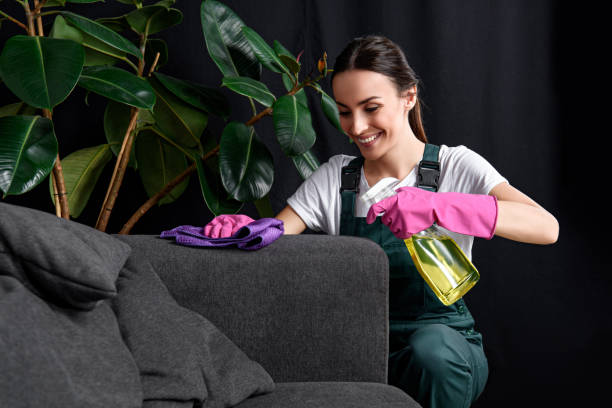Living room conversations, lazy afternoons, and cozy movie nights – your fabric couch has seen it all. However, with all the fun comes dirt, debris, and the occasional spills. This blog post is all about keeping your beloved couch looking as presentable as day one and learn how to cleaning your fabric couch

Introduction To Fabric Couch Cleaning
There’s more to a clean couch than meets the eye. Beyond the aesthetic appeal, a well-maintained lasts longer, is more hygienic, and can save from costly replacement expenses.
The thought of cleaning a fabric couch can be quite daunting. Fear not, dear reader! With the right tools, techniques, and a dash of patience, you’ll master the art in no time!
Different fabrics require different methods of care. It’s important to know what kind of fabric makes up your sofa, so the cleaning process is effective and prevents damage. You’ll usually find this information on the manufacturer’s tag.
Pre-Cleaning Preparations: Things To Do Before You Begin
Vacuum cleaner, upholstery cleaning solution, soft-bristled brush, white cloth, and a bucket of warm water – these are your weapons of grime destruction.
The little tag on your couch isn’t just for show! Understanding these symbols can guide you on what kind of cleaning treatments your couch can tolerate.
Remove cushions and loose parts. Vacuum the surface thoroughly. This helps in eliminating surface dust and dirt.
Detailed Guide To Cleaning Fabric Couch: Step-By-Step Instructions
Use a cloth soaked in your cleaning solution to blot the stain. Remember – blot, don’t rub! Rubbing drives the stain deeper into the fabric.
The overall cleaning starts with the cushions and ends with the base. Keep room for drying after each part is cleaned.
Air dry your couch in a well-ventilated area away from direct sunlight. Vacuuming once a week ensures dust doesn’t dull its shine.
Natural And DIY Cleaning Solutions: Gentle Cleansing For Your Couch
A homemade mix of white vinegar and water can be a cheap and safe cleaner for your fabric couch.
Baking soda, a natural deodorizer can remove odor and mild stains from your couch.
Not all stains can be removed with DIY solutions. Make sure to evaluate your situation before starting the cleaning process.
Routine Maintenance Tips: Keeping Your Fabric Couch Fresh And Long-Lasting
Small steps go a long way. Regularly dusting and vacuuming your couch can keep it looking fresh and prevent build-up of dust or debris. The key is to act quickly.
You have a better chance at removing a stain if you get to it before it has time to set.
Rotating and airing out your cushions can prevent uneven wear and keeps them smelling fresh.
Conclusion
Congratulations! You are now equipped to tackle upholstery cleaning.
Remember to identify your fabric type, gather your tools, and choose the appropriate cleaning solution. Cleaning is not a one-time thing.
Regular care can extend the lifespan of your couch and keep it looking new longer. The do-it-yourself approach has its charm.
It saves money and can be quite satisfying. Bring out the cleaner in you, and make your couch shine!
Frequently Asked Questions (FAQs)
Q. How frequently should I clean my fabric couch?
A. Regular cleaning is essential to maintain the appearance and longevity of your fabric couch. As a general guideline, aim to clean your fabric couch at least every 6-12 months, depending on usage. If you have pets or small children, more frequent cleaning may be necessary. Regular vacuuming and spot cleaning can also help prevent dirt and stains from accumulating.
Q. Can I use detergent to clean my couch?
A. It’s advisable to avoid using regular detergent on your fabric couch, as it may contain harsh chemicals that can damage the fabric or leave residue. Instead, opt for a mild, upholstery-specific cleaner. Always check the manufacturer’s instructions and perform a spot test in an inconspicuous area before applying any cleaning solution to ensure compatibility with your couch fabric.
Q. What to do when my fabric couch tag is missing or faded?
A. If the care tag on your fabric couch is missing or faded, it’s crucial to identify the type of fabric before attempting any cleaning. Check the manufacturer’s website or contact them directly for care instructions. In the absence of specific guidelines, it’s safest to use a mild, water-based upholstery cleaner or seek professional cleaning services to prevent potential damage.
Q. Can I use a steam cleaner on my fabric couch?
A. While steam cleaners can be effective for cleaning fabric couches, it’s essential to use caution. Check the manufacturer’s recommendations for your specific couch fabric, as some may be sensitive to moisture or heat. Perform a spot test in an inconspicuous area before using a steam cleaner on the entire couch. If uncertain, it’s advisable to consult with a professional upholstery cleaner to ensure the safe use of a steam cleaner.
Q. What DIY solutions are safe for different types of couch fabric?
A. DIY solutions can be effective, but it’s crucial to tailor them to your specific couch fabric. For general fabric upholstery, a mixture of mild dish soap and water is often safe. However, for more delicate fabrics, such as silk or vintage upholstery, it’s best to consult with a professional Upholstery cleaner. Avoid using harsh chemicals, bleach, or abrasive brushes, as they may damage the fabric. Always test any DIY solution in an inconspicuous area before applying it to the entire couch.





Comments